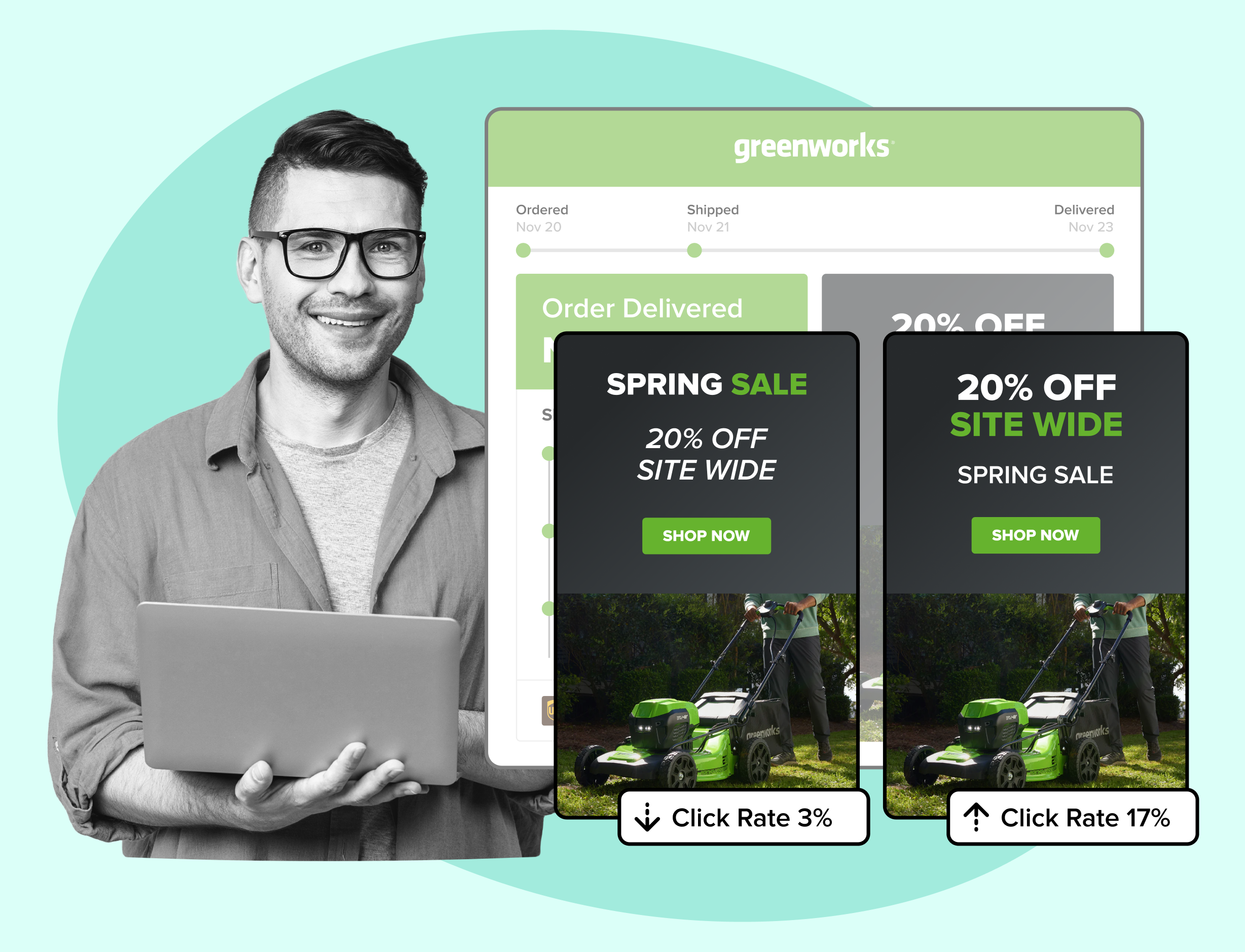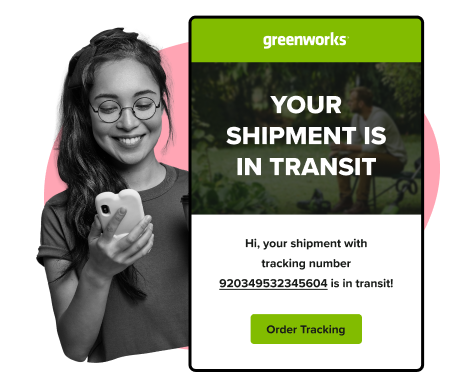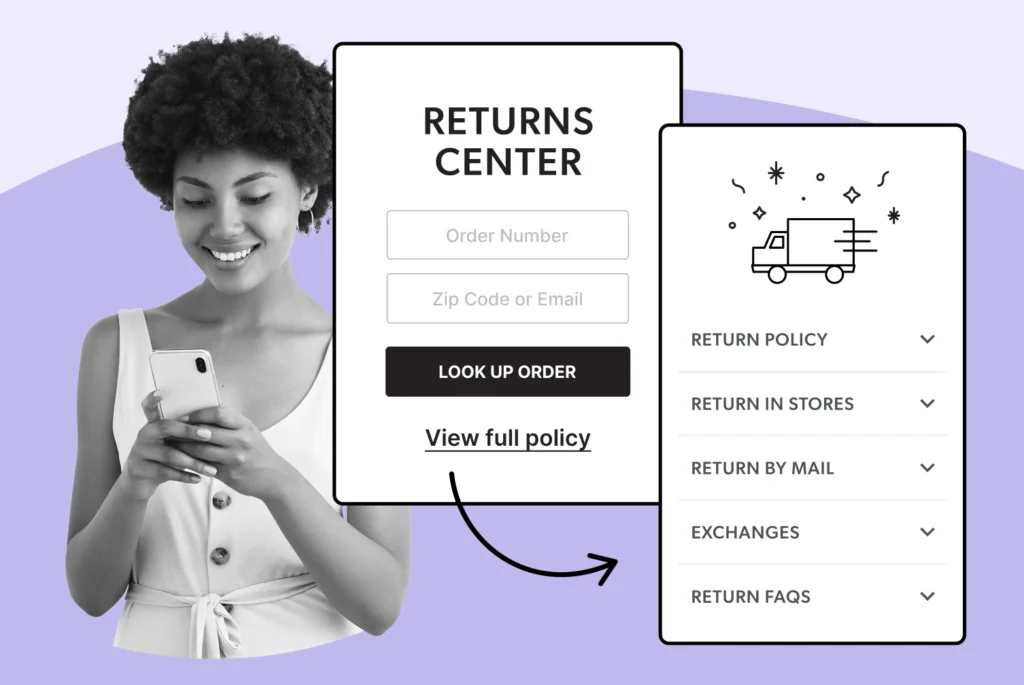
Build Your Email List from Scratch: Expert Tips for Success
Learn 7 practical strategies to effectively build your email list from scratch. Start growing your audience today! Read the article for actionable tips.
Shipping, Tracking & Notifications
Boost customer experience and reduce support tickets
Realtime order and shipment tracking
Proactive order and shipping notifications
AI-Enhanced Discounted Labels
Predictive pre-purchase estimated delivery dates
Self-Serivce branded order tracking
Effortless experience delivered
Identify and Resolve Order Issues
Realtime order and shipment tracking
Make returns profitable and delight customers
Flexibility to define any return destinations & conditions
Simplify returns for your customers and team
Incentivize exchanges over returns
Returns management made easy for your team
Returns management made easy for your team
Easy claims and smart upsells
Understand why your customers are returning
In-Store & Curbside Pickup
Unify the online and the in-store experience
Hassle-free pickup experience for customers
In-Store dashboard to keep operations streamlined
In-Store and Online orders unified
Drive foot-traffic to your stores
Shipping, Tracking & Notifications
Boost customer experience and reduce support tickets
Realtime order and shipment tracking
Proactive order and shipping notifications
AI-Enhanced Discounted Labels
Predictive pre-purchase estimated delivery dates
Self-Serivce branded order tracking
Effortless experience delivered
Identify and Resolve Order Issues
Realtime order and shipment tracking
Make returns profitable and delight customers
Flexibility to define any return destinations & conditions
Simplify returns for your customers and team
Incentivize exchanges over returns
Returns management made easy for your team
Returns management made easy for your team
Understand why your customers are returning
In-Store & Curbside Pickup
Unify the online and the in-store experience
Hassle-free pickup experience for customers
In-Store Dashboard to keep operations streamlined
In-Store and Online orders unified
Drive foot-traffic to your stores
Boost customer experience and reduce support tickets
Realtime order and shipment tracking
Proactive order and shipping notifications
AI-Enhanced Discounted Labels
Predictive pre-purchase estimated delivery dates
Self-Serivce branded order tracking
Effortless experience delivered
Make returns profitable and delight customers
Flexibility to define any return destinations & conditions
Simplify returns for your customers and team
Incentivize exchanges over returns
Returns management made easy for your team
Equip your team for precise return checks.
Easy claims and smart upsells
Understand why your customers are returning
Unify the online and the in-store experience
Hassle-free pickup experience for customers
In-Store Dashboard to keep operations streamlined
In-Store and Online orders unified
Drive foot-traffic to your stores
Find the answer to all your questions
Take a step by step trip through our functionality to see how we can improve your ecommerce processes.
Explore the most comon questions about WeSupply
Calculate the ROI that WeSupply can bring you
Read actionable articles on how to optimize your post-purchase experience and decrease support tickets
Get inspired by stories of how our customers implemented an effortless post-purchase experience
Wondering if WeSupply is a good fit for you? Read through our use cases to see how we can help you increase conversion & improve CX!
A Deep Dive into Top Companies' Order Tracking & Returns Strategy
Find the answer to all your questions
Explore the most comon questions about WeSupply
Calculate the ROI that WeSupply can bring you
Request a no strings attached review of your current shopping experience and missed conversion opportunities
Take a step by step trip through our functionality to see how we can improve your ecommerce processes.
Read actionable articles on how to optimize your post-purchase experience and decrease support tickets
Get inspired by stories of how our customers implemented an effortless post-purchase experience
A Deep Dive into Top Companies' Order Tracking & Returns Strategy
Wondering if WeSupply is a good fit for you? Read through our use cases to see how we can help you increase conversion & improve CX!

In the competitive world of eCommerce, success often comes down to how well you understand and respond to your customers. A/B testing, or split testing, allows merchants to make data-driven decisions by comparing two or more versions of a web page or marketing element to see which one performs better. By analyzing the behavior of site visitors, rather than guessing what your audience prefers, A/B testing provides clear, actionable insights. This practice is no longer optional; it’s a vital part of staying ahead in a saturated digital marketplace.
A/B testing involves presenting different test variations of a webpage or feature to different segments of your audience and analyzing which variation performs better based on predetermined KPIs such as conversion rates, click-through rates, or bounce rates. For example, you might test two different product descriptions to see which one drives more purchases. The goal is to use real customer behavior to guide website and marketing optimizations that enhance performance and revenue.
The benefits of A/B testing are profound. It enables eCommerce businesses to maximize ROI by refining aspects of the shopping experience based on data, not assumptions. Successful A/B testing can lead to significant increases in conversion rates, reduce cart abandonment, and boost average order values. Moreover, it allows for continual improvement and agility in adapting to user behavior and preferences, giving merchants a competitive edge. It is crucial to run tests over complete timeframes, such as full weeks, to ensure robust and reliable results.
There are many aspects of an eCommerce site that can be optimized through A/B testing. Product pages are a prime candidate—from images and titles to descriptions and price displays. Checkout processes can be fine-tuned by testing button colors, field layouts, or the inclusion of guest checkout options. Optimizing the checkout page is crucial as it merges customer engagement with the final purchase decision, and a seamless experience can significantly impact sales. Merchants should also experiment with navigation menus, filtering systems, and search functionalities to reduce friction. For mobile users, testing page speed, responsive design, and touch interface layouts is critical. Personalized recommendation placements and styles can also influence engagement and should be tested.
Several tools make A/B testing accessible, from beginner-friendly to enterprise-grade solutions. Google Optimize, although recently deprecated, was a popular free option; alternatives include VWO, Optimizely, Convert, and AB Tasty. These tools often integrate with Google Analytics, allowing for deeper data analysis. Form analytics, a key feature of VWO, enhances user experience insights by analyzing how visitors interact with forms on websites, providing deep visitor behavior insights alongside other tools like heatmaps and session recordings. When selecting a tool, consider your store’s size, complexity, and your team’s technical capability. Larger operations may benefit from tools offering multivariate testing and in-depth segmentation features.
Running a successful A/B test starts with defining a clear goal and hypothesis. Identify the page or element you want to test and determine what success looks like. Create a control (the current version) and a variation (the modified version). Make sure your traffic is evenly split between the two and run the test long enough to reach statistical significance. Pre-test tools like on-site surveys and heatmaps can guide your test design by highlighting friction points. Post-test, use tools like Google Analytics to evaluate results and apply insights. Additionally, it is crucial to analyze test results beyond aggregated data to uncover critical insights and understand varying impacts on different visitor groups.
To ensure reliable outcomes, test only one variable at a time. Multivariate tests are possible but require larger traffic volumes. Always aim for a statistically significant sample size to avoid misleading results. Set a fixed testing duration and avoid making changes mid-test. Analyze both macro metrics (like conversion rate) and micro interactions (like hover or scroll behavior). Finally, segment your audience to identify if results vary by device, location, or traffic source. Nuanced test analysis is crucial as it can reveal how different segments respond to changes, leading to more informed decision-making.
Merchants should focus their A/B testing strategies on areas that influence revenue. This includes optimizing product page layouts, enhancing calls-to-action, and improving upsell and cross-sell features. Test promotions and discount displays to find what resonates most with customers. Also, prioritize testing for mobile devices, where user behavior often differs significantly from desktop. Continuously test and refine various elements of the website to adapt to market changes and improve the overall customer experience. Personalized product recommendations and homepage banners are also key areas to experiment with.
Measuring the success of A/B testing is crucial to understanding the impact of changes on an eCommerce site. To do this effectively, businesses should track key performance indicators (KPIs) such as conversion rates, click-through rates, and average order value. These metrics provide a clear picture of how different versions of a product page, email, or marketing campaign perform.
Analyzing test results allows businesses to make data-driven decisions that enhance the customer experience. It’s essential to collect enough data to ensure statistical significance, which means running tests long enough to gather a reliable sample size. Avoid testing multiple variables simultaneously, as this can lead to skewed results and make it difficult to pinpoint what caused any observed changes.
By continuously testing and analyzing results, businesses can identify areas for improvement and make incremental improvements that drive eCommerce growth. This ongoing process helps refine the online shopping experience, leading to higher conversion rates, increased average order values, and ultimately, more satisfied customers.
Understanding test results is crucial. Use statistical tools to determine significance and look at confidence levels to ensure reliability. Inconclusive or negative results still offer value by ruling out ineffective changes. Document learnings and feed them into future test planning. Always contextualize results within the broader customer journey and market conditions to draw meaningful conclusions. Insights from these results should be used to inform future experiments, creating a learning cycle that fuels ongoing optimization.
Implementing the results of A/B testing is critical to driving eCommerce success. Once a business has determined which version of a product page or marketing campaign performs better, they should implement the winning version and continue to test and refine it. This data-driven approach ensures that businesses are making informed decisions and optimizing their online store for maximum conversion rates and customer satisfaction.
Using tools like Google Optimize and Google Analytics, businesses can easily implement and track the results of A/B tests. These tools help make adjustments to product page layouts, product descriptions, and calls to action, improving the overall buying process. Additionally, businesses should consider using user testing and on-site surveys to gather more insights into user behavior and preferences, identifying areas for future tests.
By following these best practices, businesses can unlock significant improvements in conversion rates, average order value, and customer satisfaction. This continuous cycle of testing and refinement drives long-term eCommerce growth, ensuring that the online store remains competitive and responsive to customer needs.
Common pitfalls can derail even the best testing strategies. Testing too many variables at once muddies the water. Failing to reach statistical significance can lead to false positives. Seasonal changes, traffic spikes, or external events can skew results if not accounted for. Conducting tests over 1-2 full business cycles is crucial to obtain comprehensive insights into user behavior, as this timeframe captures daily and weekly traffic patterns. Stopping a test early because early results look promising is another frequent error. Lastly, ignoring differences between mobile and desktop users can result in misleading conclusions.
A/B testing shouldn’t be a one-time effort. Make it a foundational part of your optimization strategy. Build a testing calendar and prioritize high-impact areas. Encourage cross-functional collaboration between marketing, design, and development teams. Understanding your target audience is crucial to enhance ecommerce strategies and improve customer experiences. Use insights from customer service interactions, user feedback, and analytics to generate new testing ideas. Over time, this approach will foster a culture of experimentation and continuous improvement.
Testing ideas can come from various sources. Analyze competitor websites for inspiration. Dive into heatmaps and session recordings to see where users struggle or drop off. Use customer support queries and product reviews to identify potential confusion or dissatisfaction. Study cart abandonment rates, checkout completion funnels, and user path flows to uncover friction points. Utilize user behavior analytics to gain insights into visitor interactions, which can generate new testing ideas. Surveys and direct customer feedback also yield powerful test ideas.
A/B testing is all about learning what works best for your customers — but what happens after you get the results? Whether your test reveals a need for a new return flow, a different message on your tracking page, or a complete overhaul of your post-purchase experience.
WeSupply’s flexible and customizable platform ensures you’re never locked into a rigid system. Instead, you can adjust and evolve your post-purchase experience as often as your testing demands — without starting from scratch. From subtle tweaks to full-on strategy pivots, WeSupply helps you turn insights into action quickly and confidently.
Simplify Returns for Your Customers and Support Team
Book a quick call with our experts to see how WeSupply can help you: simplify the Return experience with just a few clicks, reduce customer service calls and manual processing, notify your customer about their refund, automate returns and reduce user error.
✏️ Editable Tracking Pages – Need to change the layout, copy, or visuals based on engagement data? Done in a few clicks.
💬 Dynamic Post-Purchase Messaging – Adjust confirmation emails, return notifications, and tracking alerts to reflect what resonates best with your audience.
🚀 Quick Implementation – Roll out changes fast to stay agile and responsive to test findings — no developer bottlenecks.
In a landscape where every decision should be driven by data, WeSupply doesn’t just support your A/B testing — it evolves with it. No matter what your tests reveal, WeSupply gives you the tools to adjust, optimize, and grow with confidence. A/B testing helps you discover what works. WeSupply helps you act on it. Book a demo today!
Combat inconvenience with proactivity & self service
Book a quick call with our experts to see how WeSupply can help you make returns easy for your customers with a beautiful, self-service solution that makes their experience easier while also providing new ways to lower costs and earn back revenue.
Real-life success stories highlight the power of A/B testing. For instance, an online apparel brand improved their CTA wording from “Buy Now” to “Get Yours Today” and saw a 25% increase in conversions. Another retailer adjusted their mobile checkout to include autofill and streamlined forms, reducing cart abandonment by 30%. Large retailers like Amazon, the largest online retailer, continually test small changes that cumulatively make a significant impact, shaping customer experience through constant experimentation and innovation.
A/B testing empowers eCommerce merchants to build better user experiences and boost sales with precision. By relying on data over hunches, you gain insights into what truly resonates with your audience. From product pages to checkout flows, nearly every element of your site can be optimized. Begin with small tests, ensure statistical rigor, and build a culture of experimentation. Utilizing actionable data from these tests enables informed business decisions that align closely with customer needs. With A/B testing, every click is an opportunity to learn and improve your online business.
A/B testing compares two versions of a web element to see which performs better, helping merchants make data-driven decisions. It boosts conversions, reduces cart abandonment, and enhances the shopping experience. Paired with WeSupply’s customizable post-purchase tools, you can instantly apply test insights to returns, tracking, and messaging.
WeSupply adapts seamlessly to A/B testing outcomes. You can easily update return flows, tracking pages, and post-purchase messages based on your test results—without needing developers or complex coding.
Very quickly. WeSupply’s platform is built for speed and flexibility—roll out changes to your returns portal, email templates, or tracking pages within minutes and monitor impact with real-time reporting.
Yes, WeSupply does have an official Shopify App. You can download and begin to integrate it with your Shopify store.
Yes, WeSupply has an official extension for Magento. The WeSupply x Magento integration allows for automating order tracking experiences, reducing customer inquiries, automating shipping email and SMS notifications, and providing a fully branded order tracking experience
Yes, WeSupply has an official BigCommerce App. You can integrate WeSupply with your BigCommerce store to improve your post-purchase customer experience.

Learn How To Create Successful Post Purchase Email Campaigns
Build an effective post-purchase email flow that helps you increase customer satisfaction and drive revenue growth!

Learn 7 practical strategies to effectively build your email list from scratch. Start growing your audience today! Read the article for actionable tips.

Discover strategies for efficient cross-border deliveries and returns. Streamline your logistics with practical solutions. Read the article now!

Explore the defining traits of Gen X in our comprehensive guide. Understand their values, challenges, and contributions. Read the article for insights!

Stay compliant with the latest hazmat shipping rules. Discover essential tips to navigate the complexities and ensure your shipments are safe!

Discover effective return policy page examples that can boost customer trust and satisfaction. Enhance your business strategy!

Learn how RMA impacts Shopify and BigCommerce merchants, streamlining returns and boosting customer satisfaction. Read the article for essential insights.

Explore the defining traits of Gen X in our comprehensive guide. Understand their values, challenges, and contributions. Read the article for insights!

Explore the pros and cons of a 30-day return window for buyers and sellers. Understand the impact on purchases and sales!

Discover effective return policy page examples that can boost customer trust and satisfaction. Enhance your business strategy!